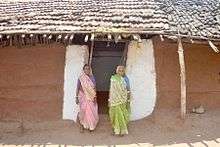Tadvi Bhil
| Tadvi Bhil | |
|---|---|
| Languages | Marathi and Bhili |
| Populated states | Maharashtra and Madhya Pradesh |
| Subdivisions | 12 main clans |


The Tadvi Bhil is a tribal community found in the states of Maharashtra, Gujarat, Madhya Pradesh and Rajasthan in India. They are from the larger Bhil ethnic group, and are a clan of it. They use the surname Tadvi or sometimes the name of their Kul or Gan; the Dhankas of Gujarat and Maharashtra use Tadvi or Tetariya.[1]
History and origin
The Tadvi Bhil inhabit an area which roughly covers the border areas of the states of Gujarat, Madhya Pradesh and Maharashtra. This territory forms the core of the Faruqi kingdom, a medieval state in central India. In the Western part of this area, Tadvis and Vassawas are mainly Hindu but some Christian missionary activities are seen in this region.[2] A close association between the Bhil of this region, and the Faruqi state led to the conversion of some of them to Islam. As they was converted from indigenous faiths and Hinduism, the RSS has initiated steps for their reversion right back to their original faith, which is still seen in their day-to-day activities[3]
The Tadvi Bhil in Maharashtra consist of three sub-groups, the Tadvi proper, the Nirade, and Nahay. Each of these groups intermarry, although the Tadvi proper perceive themselves to be superior.[4]
Present circumstance
The Tadvi speak a dialect of their own, also known as Tadvi, but many are switching to Hindi and Marathi. Their language is also Dhanka, which belongs to the Bhil group of the Indo-Aryan language family. They inhabit villages which are largely Tadvi. The community consist mainly of small cultivators. Like the wider Bhil community, they maintain the custom of gotra exogamy, and are strictly endogamous.[5] In Maharashtra, their main clans are the Sirsat, Mankar, Dhopi, Tadvi, Kedar, Masre, Khate, Ghatte, Solanki and Wadhe.
As of 2001, the Tadvi Bhil of Rajasthan were classified as a Scheduled Tribe under the Indian government's reservation program of positive discrimination.[6]
References
- ↑ https://trti.gujarat.gov.in/tadvi
- ↑ <"Disappearing Peoples? Indigenous groups and ethnic minorities of south and central asia" By Barbara Brower and Barbara Rose Johnston, firstly published 2007 by Left Coast Inc. and by Routledge New York ISBN 978-1-59874-121-6(pbk)>
- ↑ The Milli Gazette, Print Edition 16-31 Dec 2016 and Online on 28 Dec 2016>
- ↑ People of India Maharshtra Volume XXX Part One edited by B.V Bhanu, B.R Bhatnagar, D.K Bo se, V.S Kulkarni and J Sreenath pages 326-335
- ↑ Marginal Muslim Communities in India edited by M.K.A Siddiqui pages 1 to 13 Institute of Objective Studies
- ↑ "List of Scheduled Tribes". Census of India: Government of India. 7 March 2007. Retrieved 27 November 2012.